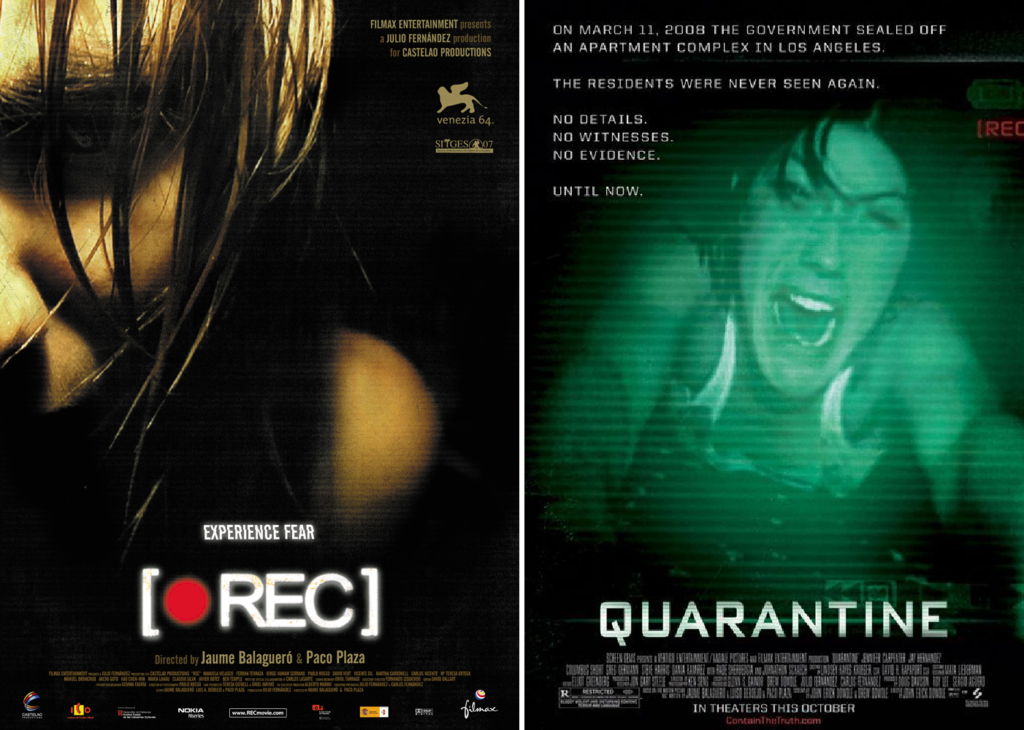
The Problem with Remakes
Remakes plague the horror genre, typically the result of studio greed wishing to capitalize on a familiar name without putting the care into developing a quality product. While they usually have higher production and bigger actors, remakes typically miss the point as to what made their predecessors such successes.
One of the most glaring examples of this fallacy is in ‘Quarantine’ (2008), by John Erick Dowdle, an Americanized remake of a Spanish film from just the year prior, ‘REC’ (2007), directed by Jaume Balaguero and Paco Plaza. These are found-footage horror films that follow a midnight news crew, who are trapped in a quarantined apartment after following firemen on a service call.
In regards to plot, both films are exactly the same; ‘Quarantine’ is almost a shot-for-shot remake of ‘REC’. But several minor changes, including those to its main character, demonstrates the narrow-mindedness of American horror, and a lack of understanding what made ‘REC’ a cult hit.
REC
The Plot
‘REC’ follows a news anchor, Angela Vidal (Manuela Velasco), who orders her cameraman to film everything they see after one of the firemen is bitten by a crazed old woman. The situation and tension escalate as more of the residents demonstrate similarly savage behavior.
As one of the first films of the found-footage genre, ‘REC’ executes its horror in being as grounded as possible. The actors are all mainly unknown, giving to the illusion that what the audience is watching is real footage. The cinematography by Pablo Rosso, who plays himself as Angela’s loyal cameraman, joins forces with the sound design to craft an authentic atmosphere.
The only lighting in the film is from the dimly-lit lamps in the foyer, and Pablo’s camera. Essentially a flashlight, the glow cast across the environment is hard and ugly, rendering the apartment all the eerier. There is no music, and the only sounds are those provided by the environment. In utter silence, every scuff of one’s boot, ragged inhale, monstrous screech or word spoken is emphasized further by the vast emptiness of the apartment.
Edits in the film are few, and there are times when the camera realistically fails when, for example, something hits the mic. In one scene, Angela and Pablo scramble throughout the apartment for a key to the penthouse, both terrified, alone, and panting. The camera swings around shakingly. They tear apart the owner’s room with loud crashes of drawers, wherein one instance Angela hits the camera, cutting out the sound for a completely silent five seconds, before crashing back into sound and the metallic tinkle of several keys.
The Cinematography
Because the camera is a character, ‘REC’s’ cinematography, pacing, and characters feel more personal to the audience. Limited to one perspective, the film benefits from being horrifyingly mysterious. No one knows why the virus is spreading, what it is or where it came from. The audience hears second-hand accounts of the outside being surrounded by cops; the frightened residents start whispering scary words like “nuclear,” “biological,” and “chemical.”
In a chilling scene, Angela runs to a window just in time to find the building covered and vacuum-sealed in plastic. When someone from the outside finally enters the building, it’s a health inspector clad in a biohazard suit—an appearance that instills, at the very least, a sense of unease within the audience. It’s faceless, deprived of humanity, and typically associated with a grave, biological scenario.
The apartment residents are terrified; whenever a horrific development happens, they all start panicking and talking over one another, wanting to be heard. It’s a very human reaction; the impact enhances with the audience feeling like they’re present as a result of the camera being its own character.
(Article continues after the ad)
Please follow our fantastic site sponsors! They make content like this possible! 🙂
Quarantine
Despite being a shot-for-shot remake of this excellently-crafted horror film, the few changes ‘Quarantine’ reveals a troubling mindset in the American filmmakers.
The first problem is the film’s very existence. Foreign films are usually looked down upon in America. Despite being a fan favorite within the U.S., and a big hit in Spain, American producers saw the potential in ‘REC’s’ idea, and its international gross of $32 million was too mouthwatering to resist. But because of the stigma against foreign films, and because most American filmgoers don’t like to read the subtitles, producers took it upon themselves to obtain the rights for a remake.
As a result, ‘Quarantine’ is, by and large, just an Americanized ‘REC’ instead of forming its own identity. The camera’s footage is too clean; there are few technical disruptions like in the original, which renders the film appearing too clean to be as gritty. The “real” illusion is ruined further by casting a star, Jennifer Carpenter, as Angela, along with several lesser-known stars as opposed to emerging actors or largely unknown ones.
Issues With the Remake
The core of the concept is ruined before the film starts because the authentic illusion is rendered moot. The producers are to blame for this, as it is a common belief in American filmmaking that familiar names rake in more attendees. But having a recognizable face in a found-footage movie defeats the purpose of it being a found-footage movie. The horror aspect skews because audiences familiar with Jennifer’s face remember her as “that girl from ‘Dexter’.”
The execution of the plot has minor “tweaks” to it that, too, hurt the film further. One of the more subtle, but gripping aspects of the narrative is the characters, and by proxy the audience, not understanding anything about the virus.
No one is a medical professional in ‘REC’, but one of the new residents in ‘Quarantine’ had to be a veterinarian so she could reveal that the disease might be linked to rabies. In the climax of the film, when Angela and her cameraman find themselves in the penthouse where the virus seemingly originated, they find the owner’s audio diary who reveals this very information as if it’s our first time discovering this.
What Made ‘REC’ So Successful
‘REC’s’ original scene is unsettling because this isn’t what the disease is revealed to be—the penthouse owner was originally a clergyman of the Vatican, and he suggests this infection is more of mass possession. This was changed in ‘Quarantine’, likely because to some that felt too hokey to be taken seriously.
‘REC’ sold this idea because the reveal in the penthouse is done entirely in the environment, with a worn, crackling audio diary droning in the background as Pablo captures shots of numerous newspaper clippings talking about paranormal activity in the Vatican area. It worked because the film took it seriously, and took the steps to authenticate that idea.
While ‘REC’ executed its horror through gritty, real acting, atmosphere and subtle visual cues and technical tricks, ‘Quarantine’ blatantly doubled the residents of the apartment as an excuse to have more deaths.
The film is bloodier, as a result, even in scenes from ‘REC’ that were less about the spectacle and more about the gravity of the situation. In one gratuitous example, a fireman is thrown over the balcony and dies upon landing in the foyer, but in ‘Quarantine’ he rises again with a leg that’s splitting at the shin, and the camera makes sure to capture the blood spurting out. It is unnecessary, but it echoes an oft-repeated standard of American horror needing to be gory in order to be scary.
Where ‘Quarantine’ Falls Short
The more unofficial reason, which many believe already, is the assumption that Americans will find the atmosphere and slow pacing to be boring. They need action, and thus, throwing gore and bodies at the screen will make the film more exciting. This is made more obvious when the trailer for ‘Quarantine’ spoils the film’s very last shot, purely because it’s an exciting note to end on.
Story and character do not hold as much precedence in American horror as spectacle does, even though story and character are what engaged the audience with a story that would grip them, and thus, horrify them when it needs to.
Lastly, there is a change in Angela’s character between movies that suggests sexism in the mind of Dowdle.
In ‘REC,’ although she deteriorates like everyone else, Angela keeps a clear enough head to at least function. In ‘Quarantine,’ not only does she involve herself less in the scenes where the action is happening, but Angela also screams frantically, cries, and becomes so unintelligible it makes one wonder what the point of Americanizing ‘REC’ even was.
Combined with an earlier scene added by ‘Quarantine,’ where the firemen joke about bedding Angela by the end of the night, there is such clear, casual sexism in the execution and usage of her character.
An Unnecessary Remake and a (Still) Successful Original
Often horror movie remakes are careless cash grabs by American studios, missing the art of the genre and what made the originals such successes. Modern horror in America capitalizes on cheap thrills while putting no effort into understanding what actually engages the audience.
Despite making around the same worldwide gross, ‘Quarantine’ has been largely forgotten or panned while ‘REC’ went on to become a series of four movies. It is a shame that American values and beliefs infect good movies into shadows of what they are, even in the execution of female characters in this day and age.
Thank you to our supporters and sponsors!
As always, we want to thank our Patreon’ Cultivator’ supporters and sponsors who help make content like this possible.
The following Patron(s) supported the production of this article:
Crystal Gropp
The following sponsors supported the production of this article:
Viva La Compost & LunaKai Lash
Works Cited
Balaguero, Jaume, et al. Rec. Filmax, 2007.
Dowdle, John Erick, et al. Quarantine. Screen Gems, 2008.
Image source
‘REC’ theatrical poster and IMBD: https://www.imdb.com/title/tt1038988/
‘Quarantine’ theatrical poster and IMBD: https://www.imdb.com/title/tt1082868/



